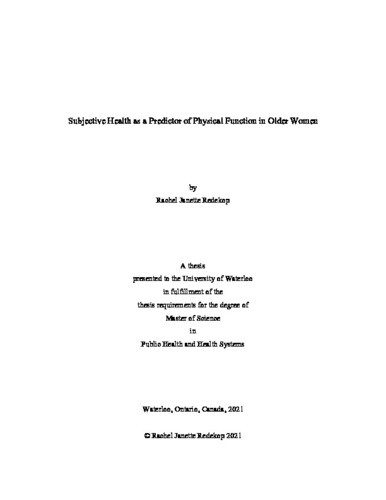| dc.contributor.author | Redekop, Rachel | |
| dc.date.accessioned | 2021-01-20 17:04:24 (GMT) | |
| dc.date.available | 2021-01-20 17:04:24 (GMT) | |
| dc.date.issued | 2021-01-20 | |
| dc.date.submitted | 2020-01-19 | |
| dc.identifier.uri | http://hdl.handle.net/10012/16702 | |
| dc.description.abstract | Introduction: Globally, populations are ageing, which has increased the urgency of supporting health in older adults. Two key measures used to examine health in older populations are subjective health, a measure of global health, and physical function, a measure of functional ability and disability. Subjective health is a predictor of physical function; however, it is not clear whether this relationship remains significant in older women.
Aims: The purpose of this study was to determine the association between subjective health and subsequent physical function in older women and whether that association changes with time and measure of subjective health.
Methods: This study used data from the Nun Study, a cohort study of 678 religious sisters aged 75+ at baseline. Data on up to 12 approximately annual assessments included measures of subjective health (self-rated health and function) and physical function (basic and instrumental activities of daily living). Using baseline self-rated health and function as independent exposures and subsequent basic and instrumental activities of daily living as independent outcomes, generalized estimating equations conditional upon survival were developed to address the aims of this study.
Results: Self-rated health was a significant predictor of independence in instrumental but not basic activities of daily living. In contrast, self-rated function was a significant predictor for both basic and instrumental activities of daily living. Overall, self-rated function was a stronger predictor of physical function than self-rated health.
All relationships showed a positive dose-response between subjective health and physical function. Further, the relationships between self-rated health and physical function, and between self-rated health and instrumental activities of daily living were not modified by time. However, the relationship between self-rated function and basic activities of daily living was modified by time, such that the relationship became stronger at assessments further from baseline.
Conclusion: Subjective health, specifically self-rated function, is a promising measure that could be used to identify older women at risk for decline in physical function for over a decade from baseline. Thus, subjective health could be used to inform treatment plans to prevent functional decline and to predict trajectories of health needs for older women. | en |
| dc.language.iso | en | en |
| dc.publisher | University of Waterloo | en |
| dc.subject | subjective health | en |
| dc.subject | physical function | en |
| dc.title | Subjective Health as a Predictor of Physical Function in Older Women | en |
| dc.type | Master Thesis | en |
| dc.pending | false | |
| uws-etd.degree.department | School of Public Health and Health Systems | en |
| uws-etd.degree.discipline | Public Health and Health Systems | en |
| uws-etd.degree.grantor | University of Waterloo | en |
| uws-etd.degree | Master of Science | en |
| uws-etd.embargo.terms | 0 | en |
| uws.contributor.advisor | Tyas, Suzanne | |
| uws.contributor.affiliation1 | Faculty of Applied Health Sciences | en |
| uws.published.city | Waterloo | en |
| uws.published.country | Canada | en |
| uws.published.province | Ontario | en |
| uws.typeOfResource | Text | en |
| uws.peerReviewStatus | Unreviewed | en |
| uws.scholarLevel | Graduate | en |

